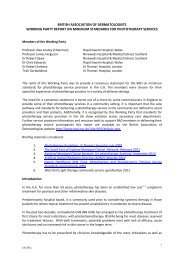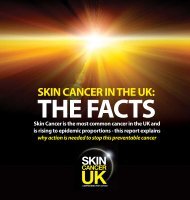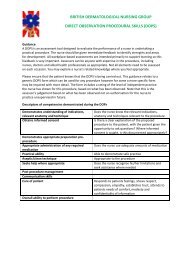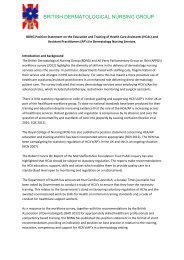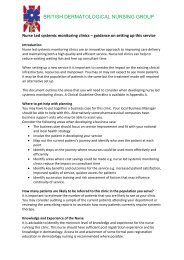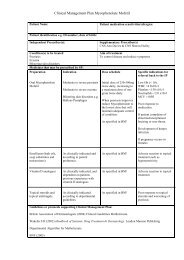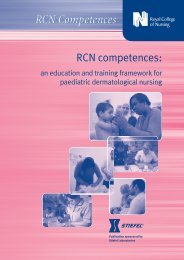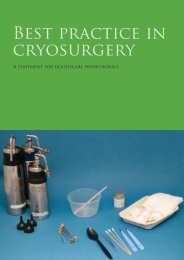Improving outcomes for people with skin tumours including melanoma
Improving outcomes for people with skin tumours including melanoma
Improving outcomes for people with skin tumours including melanoma
Create successful ePaper yourself
Turn your PDF publications into a flip-book with our unique Google optimized e-Paper software.
<strong>Improving</strong> Outcomes <strong>for</strong><br />
People <strong>with</strong> Skin Tumours<br />
<strong>including</strong> Melanoma<br />
Initial investigation,<br />
diagnosis, staging and<br />
management<br />
All cases referred to the SSMDT should have a specialist<br />
histopathology review.<br />
An appropriately resourced national system <strong>for</strong> histopathology tertiary<br />
review should be established. Currently, several thousand complex<br />
and/or rare <strong>skin</strong> cancer cases per year require tertiary opinions from<br />
a small number of in<strong>for</strong>mally recognised national expert specialist<br />
dermatopathologists. Even <strong>with</strong> the <strong>for</strong>mation of larger pathology<br />
networks, the complexity of these cases indicates that this tertiary<br />
referral practice will continue to be necessary to obtain the correct<br />
diagnosis and thereby maximise the quality of patient treatment and<br />
care. All SSMDT cases falling into this category should have full<br />
access to this tertiary referral facility when supported by the SSMDT.<br />
Commissioners should be aware of the funding implications. These<br />
services, which may cross many network boundaries, should be<br />
commissioned through the specialised services commissioners.<br />
4<br />
MDTs should complete the national cancer datasets <strong>for</strong> common <strong>skin</strong><br />
cancers and <strong>for</strong> lymphoma. 49,50<br />
Management of precancerous lesions<br />
Where there is any doubt about the diagnosis, the patient should be<br />
referred <strong>for</strong> a specialist opinion as described in Box 1 and Figure 14.<br />
All excised <strong>skin</strong> specimens should be sent <strong>for</strong> histopathological<br />
examinations as recommended in the NICE Referral guidelines <strong>for</strong><br />
suspected cancer. 51<br />
Patients <strong>with</strong> two or more atypical naevi, and giant congenital naevi<br />
where there is a suspicion of malignant trans<strong>for</strong>mation, and who<br />
need assessment and education should be referred to a member of<br />
the LSMDT or SSMDT (see chapter on ‘Organisation of <strong>skin</strong> cancer<br />
services’, Table 2 and Table 4).<br />
Medical photography has a special role to play in surveillance <strong>for</strong><br />
patients <strong>with</strong> atypical naevi. There<strong>for</strong>e all departments treating <strong>skin</strong><br />
cancer should have access to high-quality medical photography and<br />
storage of digital images.<br />
Any doctor or nurse who knowingly treats patients <strong>with</strong> precancerous<br />
lesions should have received locally approved training in available<br />
treatments.<br />
49 Royal College of Pathologists. Standards and minimum datasets <strong>for</strong> reporting cancers.<br />
www.rcpath.org<br />
50 www.icservices.nhs.uk/cancer/pages/dataset/default.asp<br />
51 National Institute <strong>for</strong> Health and Clinical Excellence. Referral guidelines <strong>for</strong> suspected<br />
cancer. Available from: www.nice.org.uk/CG027<br />
86<br />
National Institute <strong>for</strong> Health and Clinical Excellence




